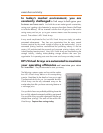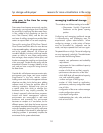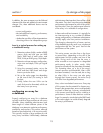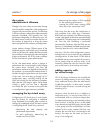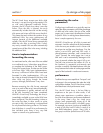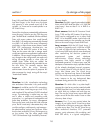
section 1
In addition, the same processes must be followed
whenever disk drives are added or the environment
changes. Plus, these additional factors must be
considered:
• current configuration
• desired additional capacity, performance,
and availability
• whether the new disks will be stripe extensions
of existing disks or be independent groups
here is a typical process for setting up
a traditional array:
1. Determine number of disks, number of RAID
groups, disks and disk type per RAID
group, RAID level of each group, total
LUNs, LUNs per RAID group, stripe depth.
2. Determine volume manager configuration,
stripe size and depth, LUNs per logical
volume.
3. Using the command station, set up the
LUNs and their RAID levels and assign
them to particular disks.
4. Set up the cache page size depending
on the size of the I/Os coming in from
the host.
5. Finally, before the new LUNs can be
used, disks must be formatted, which can
take many hours per array.
configuring an array for
a database
Properly configuring an array for a database
typically involves a large problem set with many
variables. Many database administrators have
been taught to isolate different pieces of the
database in an attempt to optimize performance,
availability, and recovery. This process, although
based on sound objectives, is far too error-prone.
This typically involves a large problem set with
many, many variables. Unfortunately, database
1
performance requirements for each of the pieces,
and they don’t know the performance behavior
of the array in its multitude of configurations.
In these real-world environments, it is typically far
too time-consuming to try a number of different
storage configurations, so database administrators
typically apply rules from previous installations.
The changing characteristics of newer versions
of the database typically result in an unbalanced
configuration that has “hot spots” that limit the
performance of the system.
This entire process can take from a few hours
to several days, depending on the skill of the
administrator and the number and size of the
LUNs. During much of this time the array is
either unusable or must operate in a degraded
performance mode. In other words, LUNs
cannot be utilized until they have been formatted.
This formatting takes up a lot of the array’s
internal resources and bandwidth. After a LUN
has been formatted, it can be used; but as long
as other LUNs in the array are also going
through their format process, the entire array
will suffer from degraded performance.
Now, a short word about human error. Every step
of this process has the potential for human error.
Except in the grossest cases, errors would probably
not result in data loss, but every miscalculation
in this process would easily result in a decline in
performance. Some of these declines could be
huge. For example, miscalculating the RAID levels
or the cache page size could severely degrade
the array’s performance.
1.3
hp storage white paper
administrators oftentimes don’t have all the critical
information. They don’t know the precise database




